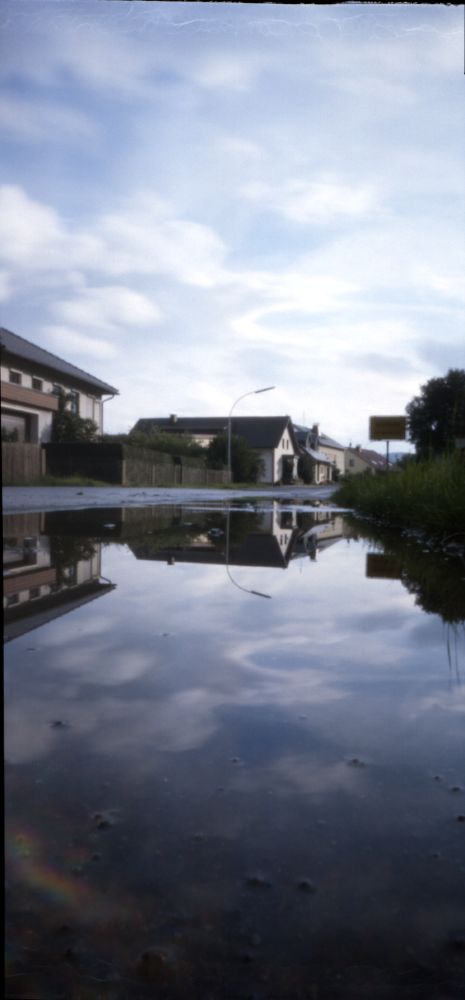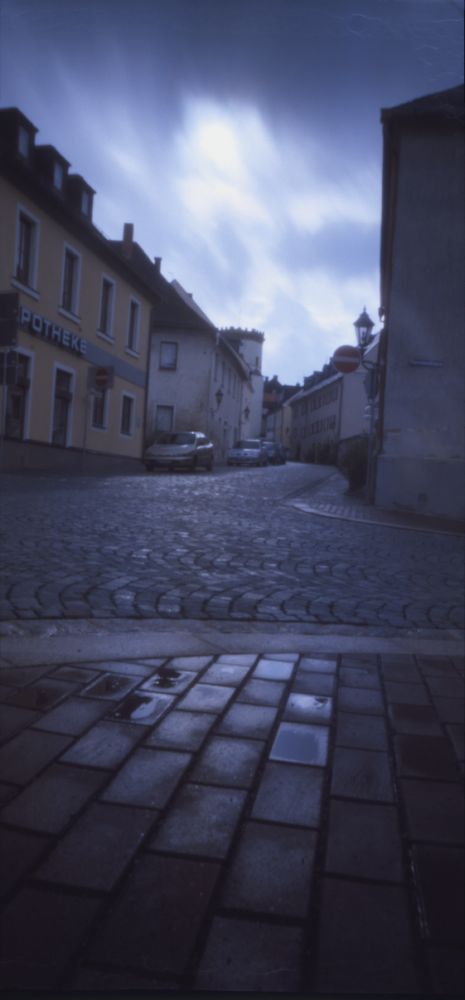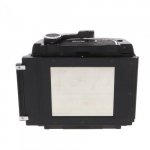mh2000
Well-known
Getting back into medium format film and I've always wanted to play with a panoramic camera. Thinking the way to get in cheap would be to make a camera out of wood.
The nice ones that I can buy all cost $150-250 and they still don't even have a real sports finder!
The only real trick is how to make the 120 wind mechanism from junk that can be easily picked up at a hardware store and thoughts for film gate and light traps? I guess simple shutter ideas would be useful too! The extent of my tools is a basic dremel and drill press.
I've been all over the internet and am really surprised at the lack of resources. I guess there are lots of people who want to make money off their skills, but I would have guessed there would have been a lot of enthusiasts who just wanted to share their passions!
Looking at the results from some of the "commercial" products, it looks like for a 6x12 format camera that a curved film plane isn't so important. 6x12 is the format I want to start with and I don't want a super-wide focal length. I was thinking something like 105mm.
Thoughts and advice appreciated!
The nice ones that I can buy all cost $150-250 and they still don't even have a real sports finder!
The only real trick is how to make the 120 wind mechanism from junk that can be easily picked up at a hardware store and thoughts for film gate and light traps? I guess simple shutter ideas would be useful too! The extent of my tools is a basic dremel and drill press.
I've been all over the internet and am really surprised at the lack of resources. I guess there are lots of people who want to make money off their skills, but I would have guessed there would have been a lot of enthusiasts who just wanted to share their passions!
Looking at the results from some of the "commercial" products, it looks like for a 6x12 format camera that a curved film plane isn't so important. 6x12 is the format I want to start with and I don't want a super-wide focal length. I was thinking something like 105mm.
Thoughts and advice appreciated!
dourbalistar
Buy more film
There are some 3D printed options like this one. Or The Kraken, which is also 3D printed, but uses a large format lens. Or the slightly less commercial versions on places like Etsy.
mh2000
Well-known
3D printing looks cool, but I don't have one. I was thinking more like plywood and spray paint! 
Rayt
Nonplayer Character
Can you rig something to mount in front of a Horseman 612 back?
Barry Kirsten
Established
Hi Mark, an excellent project and a few thoughts from me. I've built several sheet film pinhole cameras, one of which was a 5x12 inch curved plane camera. For 3:1 aspect ratio or higher I think a curved film plane is very desirable. I'm glad I chose the curved plane as there is no light fall-off or distortion at the ends of the image. But I agree, for 6x12 it's not essential. Another feature I've included in all my cameras is some form of 'lens' shift - a simple mechanism to adjust the pinhole position to prevent converging verticals or, in the case of a curved film plane, keeping the horizon straight when the camera is tilted up or down. This is entirely optional of course.
In building any type of camera I find it valuable to look at what other camera makers do and collect ideas in advance and chew them over until I come up with what I feel comfortable with. So for your camera (and the rollfilm pinhole camera I have as my next project) I'd look at Zero Image designs and see what takes your eye. I particularly like their designs because I think overall they've got everything right. For example, they have a removable top and a removable back, and although this makes the woodwork side of the build more complex, when you think of it overall the process is made simpler by this design because the film advance is simplified. And to my mind film advance is the most difficult part of the built because it has to work properly and also be light-tight.
Another thing to think about is a film count window. Some diy pinholers use a sliding scale number of turns between frames derived by trial and error, but that's not for me. So if you go with a film count window I feel a sliding window cover is a necessary part of the design because a red filter can't be trusted with panchromatic film. As for a shutter, I use a simple lens cap. Some cameras have inbuilt shutters, but why complicate things? Another benefit of the lens cap shutter is that there is a filter ring there so filters can be used. Good luck with your project, enjoy the build and the camera.
In building any type of camera I find it valuable to look at what other camera makers do and collect ideas in advance and chew them over until I come up with what I feel comfortable with. So for your camera (and the rollfilm pinhole camera I have as my next project) I'd look at Zero Image designs and see what takes your eye. I particularly like their designs because I think overall they've got everything right. For example, they have a removable top and a removable back, and although this makes the woodwork side of the build more complex, when you think of it overall the process is made simpler by this design because the film advance is simplified. And to my mind film advance is the most difficult part of the built because it has to work properly and also be light-tight.
Another thing to think about is a film count window. Some diy pinholers use a sliding scale number of turns between frames derived by trial and error, but that's not for me. So if you go with a film count window I feel a sliding window cover is a necessary part of the design because a red filter can't be trusted with panchromatic film. As for a shutter, I use a simple lens cap. Some cameras have inbuilt shutters, but why complicate things? Another benefit of the lens cap shutter is that there is a filter ring there so filters can be used. Good luck with your project, enjoy the build and the camera.
mh2000
Well-known
Can you rig something to mount in front of a Horseman 612 back?
Those are just a bit pricey for a cheap pinhole project!
mh2000
Well-known
Hi Mark, an excellent project and a few thoughts from me. I've built several sheet film pinhole cameras, one of which was a 5x12 inch curved plane camera. For 3:1 aspect ratio or higher I think a curved film plane is very desirable. I'm glad I chose the curved plane as there is no light fall-off or distortion at the ends of the image. But I agree, for 6x12 it's not essential. Another feature I've included in all my cameras is some form of 'lens' shift - a simple mechanism to adjust the pinhole position to prevent converging verticals or, in the case of a curved film plane, keeping the horizon straight when the camera is tilted up or down. This is entirely optional of course.
In building any type of camera I find it valuable to look at what other camera makers do and collect ideas in advance and chew them over until I come up with what I feel comfortable with. So for your camera (and the rollfilm pinhole camera I have as my next project) I'd look at Zero Image designs and see what takes your eye. I particularly like their designs because I think overall they've got everything right. For example, they have a removable top and a removable back, and although this makes the woodwork side of the build more complex, when you think of it overall the process is made simpler by this design because the film advance is simplified. And to my mind film advance is the most difficult part of the built because it has to work properly and also be light-tight.
Another thing to think about is a film count window. Some diy pinholers use a sliding scale number of turns between frames derived by trial and error, but that's not for me. So if you go with a film count window I feel a sliding window cover is a necessary part of the design because a red filter can't be trusted with panchromatic film. As for a shutter, I use a simple lens cap. Some cameras have inbuilt shutters, but why complicate things? Another benefit of the lens cap shutter is that there is a filter ring there so filters can be used. Good luck with your project, enjoy the build and the camera.
Thanks Barry!
First prototype is just to work out the bugs, but I definitely want to add a shift feature down the road. Thinking a sports finder like on a Speed Graphic for better framing with the shift!
Since it's mostly just a box, it's the details of the wind system that is more of a challenge. I'm thinking I can "machine" some hobby brass with my hack saw (!) to build a winder chuck with springs etc. Have to take a film spool to Ace Hardware! Yes, have looked at a few of the "commercial" products for ideas too.
There was a time when you could get a working Kodak No. 1 Panoram camera for a pretty affordable price. I really wish I would have bought one twenty years ago!
Do you have a link to some of your pinhole work?
Hari
Well-known
I got Sinar P 4x5 and a Zoom 120 roll film
back that handles all 120 formats up to 6x12.
Maybe I'll start working on it.
back that handles all 120 formats up to 6x12.
Maybe I'll start working on it.
mh2000
Well-known
I got Sinar P 4x5 and a Zoom 120 roll film
back that handles all 120 formats up to 6x12.
Maybe I'll start working on it.
If I had all of that, I'd just use an appropriate lens!
Hari
Well-known
I got three lenses for the Sinar P.
It's used mostly with 120 film.
It's used mostly with 120 film.
mh2000
Well-known
I got three lenses for the Sinar P.
It's used mostly with 120 film.
Too rich for my blood, but very awesome!
Barry Kirsten
Established
Do you have a link to some of your pinhole work?
Hi Mark, sorry I don't. I used to have a Flickr account but found it too time consuming to maintain. You could check the pinhole threads here and over on LFPF where I've posted some of my stuff. Also the Worldwide Pinhole Photography Day site has some tremendous stuff.
mh2000
Well-known
Hi Mark, sorry I don't. I used to have a Flickr account but found it too time consuming to maintain. You could check the pinhole threads here and over on LFPF where I've posted some of my stuff. Also the Worldwide Pinhole Photography Day site has some tremendous stuff.
Thanks! Will do!
narsuitus
Well-known
Thoughts and advice appreciated!
I have a Holga 120 Panoramic Pinhole camera that uses 120 roll film to make six 6cm x 12cm images.
However, I prefer to use 4x5 inch sheet film pinhole cameras and crop the 10cm x12cm image down to 6cm x 12cm. I make my 4x5 inch DIY pinhole cameras from cardboard boxes that I buy at hobby stores, PVC pipe that I buy at hardware stores, metal oatmeal cans that I buy at grocery stores, and foam core boards that I buy at WalMart.

120 Pinhole Cameras by Narsuitus, on Flickr

DIY Pinhole Cameras by Narsuitus, on Flickr
petronius
Mentor
I built a 6x12 in 2007 from 6mm plywood. The lens cap snaps on the pinhole plate with a magnet. Aperture 240.





mh2000
Well-known
I built a 6x12 in 2007 from 6mm plywood. The lens cap snaps on the pinhole plate with a magnet. Aperture 240.
that looks like something I was thinking of! Can you snap a photo or two of the inner workings? the film advance mechanism?
Thanks!
PRJ
Another Day in Paradise
I wouldn't build one myself unless I could improve on what is available. They aren't all that expensive really, especially when you factor in your time. Of course if you just want to do it yourself, then have at it.
I'd avoid the curved plane ones. If you tilt it off level it will distort, unless that is something you want.
I've been using a Holga 120WPC for about a decade now. They are decent cameras and they don't cost that much. I modified mine quite a lot over the years but if I did it all over again I would only change one or two things to get rid of vignetting and call it quits.
I'd avoid the curved plane ones. If you tilt it off level it will distort, unless that is something you want.
I've been using a Holga 120WPC for about a decade now. They are decent cameras and they don't cost that much. I modified mine quite a lot over the years but if I did it all over again I would only change one or two things to get rid of vignetting and call it quits.
PKR
Mentor
Getting back into medium format film and I've always wanted to play with a panoramic camera. Thinking the way to get in cheap would be to make a camera out of wood.
The nice ones that I can buy all cost $150-250 and they still don't even have a real sports finder!
The only real trick is how to make the 120 film wind mechanism from junk that can be easily picked up at a hardware store and thoughts for film gate and light traps? I guess simple shutter ideas would be useful too! The extent of my tools is a basic Dremel and drill press.
I've been all over the internet and am really surprised at the lack of resources. I guess there are lots of people who want to make money off their skills, but I would have guessed there would have been a lot of enthusiasts who just wanted to share their passions!
Looking at the results from some of the "commercial" products, it looks like for a 6x12 format camera that a curved film plane isn't so important. 6x12 is the format I want to start with and I don't want a super-wide focal length. I was thinking something like 105mm.
Thoughts and advice appreciated!
All my pinhole efforts have been digital. I did do some film camera design work inspired by Phil. The wooden camera with a tripod mount was designed around a 6x7 film back. I wanted a quality camera that I could easily modify. I tend to modify most things I build until I get them right - as per my use or discovered uses.
The advantage of using a film back is that you have a wind mechanism with many and a quality dark slide built in. The build cost may go up but, if the camera is a serious device and it's used a lot, it's worth the increase in investment. Lots of camera hardware items, like a tripod mount are easily found on the web.
I've built lots of camera and enlarger mods out of high quality, multi-ply plywood. It's a good building material. The mechanical interfaces are usually brass or aluminum sheet cuts.
http://www.crosscuthardwoods.com/multi-ply.html
I bought a series of very small drills, the biggest being a #80. They are are held in a pin vice on the drill press. you must carefully clean the holes as anything not optically smooth will affect the image quality. I've seen laser cut pinhole camera lenses for sale on the web. I haven't played with any I haven't made yet but, they may be a good option.
edit
Just an afterthought: if I were building a panoramic camera, I would still likely use an RB67 back, as they rotate and can likely be modified to do a 180° rotation. Mask half the frame and you have two pano film spaces per film advance. You can easily make a couple of different mounting plates for the film back depending on your needs.
Just checking prices, the backs are selling from $50-100, and rotating unit around $50 on the auction site.
Attachments
PKR
Mentor
Steve Smith's 6x12 wide field camera is really well designed and built. The body dimensions could easily be adjusted for a pinhole lens.
Check his use of old camera parts.
In planning my camera, i was going to build a few body designs out of Foamcore and would field test them, before cutting any wood.
https://www.stockholmviews.com/diy-6x12/index.html
Check his use of old camera parts.
In planning my camera, i was going to build a few body designs out of Foamcore and would field test them, before cutting any wood.
https://www.stockholmviews.com/diy-6x12/index.html
petronius
Mentor
that looks like something I was thinking of! Can you snap a photo or two of the inner workings? the film advance mechanism?
Thanks!
Here is the original thread on f295:
http://www.f295.org/main/showthread.php?4225-Wooden-6x12&highlight=petronius
Share:
-
This site uses cookies to help personalise content, tailor your experience and to keep you logged in if you register.
By continuing to use this site, you are consenting to our use of cookies.


